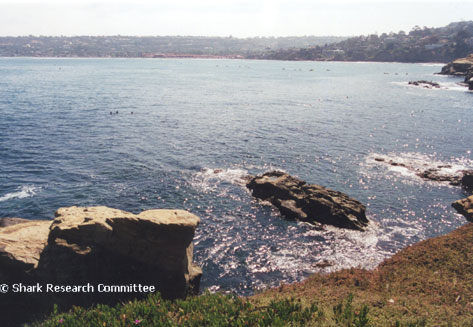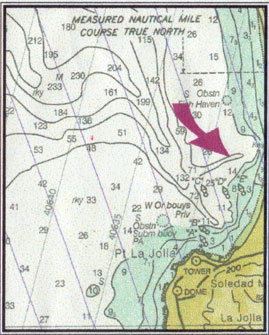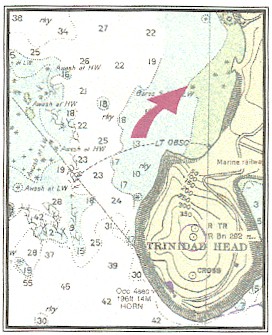| |
Unprovoked White Shark Attacks on Kayakers
Only 5 (5%) of the 108 authenticated unprovoked shark attacks reported from the Pacific Coast during the Twentieth Century involved kayakers. The first incident, and to date the only fatality for this victim group, occurred near Malibu/Paradise Cove, California, in 1989 and the last in the area of La Jolla Shores, California, in 1995. The White Shark was positively identified, or highly suspect, in all of the kayak attacks.
The following case remains one of the most
mysterious of all Pacific Coast shark attacks occurring during the
Twentieth Century. This incident was widely reported in the media; however, the individual involved was never identified. Attempts to locate this person continue to this
day.
 |
|
La Jolla Shores,
San Diego County, California
|
 On Saturday, 24 June 1995, an unidentified woman from the Sacramento,
California, area was kayaking off La Jolla Shores, at La Jolla, San
Diego County, California (about 32°52.5' N; 117°16.0' W). This was
the location of Verne Fleet's Hammerhead Shark attack and Robert Pamperin's
fatal White Shark attack, both in 1959, many years earlier. If authentic,
this would be the third attack from this "recurring location"
and the fifth attack on a female and a kayak. It was reported in several
Southern California newspapers that a San Diego physician had removed
a triangular-shaped, serrated tooth fragment from the victim's face.
The physician confirmed that he had removed a tooth fragment from
a patient and that it was serrated and triangular in shape. Unfortunately,
he could not reveal any information regarding the injured person.
Repeated attempts over the last six years to identify and/or locate
this individual through kayaking organizations throughout California
have been unsuccessful.
On Saturday, 24 June 1995, an unidentified woman from the Sacramento,
California, area was kayaking off La Jolla Shores, at La Jolla, San
Diego County, California (about 32°52.5' N; 117°16.0' W). This was
the location of Verne Fleet's Hammerhead Shark attack and Robert Pamperin's
fatal White Shark attack, both in 1959, many years earlier. If authentic,
this would be the third attack from this "recurring location"
and the fifth attack on a female and a kayak. It was reported in several
Southern California newspapers that a San Diego physician had removed
a triangular-shaped, serrated tooth fragment from the victim's face.
The physician confirmed that he had removed a tooth fragment from
a patient and that it was serrated and triangular in shape. Unfortunately,
he could not reveal any information regarding the injured person.
Repeated attempts over the last six years to identify and/or locate
this individual through kayaking organizations throughout California
have been unsuccessful.
 Only
eight days following Rodney Swan's shark encounter, and at the same
"recurring location," Matt Hinton's kayak was attacked by a
White Shark, 150 meters off Trinidad Head and Beach, Humboldt County,
California (41°03.6' N; 124°09.1' W). Hinton, age 44, was 20 to 30
meters seaward of a craggy exposed rock. The water there was 1 to
2 fathoms deep, with a temperature of 14°C. At 1700 hours, Wednesday,
5 September 1990, the sky was clear and the air temperature was 20°C.
The sea was calm and exceptionally flat, with a small westerly swell
undulating above the sandy ocean floor. No dominant kelps were noted
at the attack location. There was a mild, 5-to-7-knot northwest breeze
as the sun began to slip beneath the western horizon. Pinnipeds were
seen earlier in Trinidad Harbor, but none near the attack location.
However, there is a Harbor Seal haul-out site about 300 meters offshore
at an exposed reef. The kayak was 2.7 meters in length and colored
medium blue. Hinton was dressed in a full black wetsuit and had been
kayaking 15 to 20 minutes. This was the second shark attack from this
"recurring location." Only
eight days following Rodney Swan's shark encounter, and at the same
"recurring location," Matt Hinton's kayak was attacked by a
White Shark, 150 meters off Trinidad Head and Beach, Humboldt County,
California (41°03.6' N; 124°09.1' W). Hinton, age 44, was 20 to 30
meters seaward of a craggy exposed rock. The water there was 1 to
2 fathoms deep, with a temperature of 14°C. At 1700 hours, Wednesday,
5 September 1990, the sky was clear and the air temperature was 20°C.
The sea was calm and exceptionally flat, with a small westerly swell
undulating above the sandy ocean floor. No dominant kelps were noted
at the attack location. There was a mild, 5-to-7-knot northwest breeze
as the sun began to slip beneath the western horizon. Pinnipeds were
seen earlier in Trinidad Harbor, but none near the attack location.
However, there is a Harbor Seal haul-out site about 300 meters offshore
at an exposed reef. The kayak was 2.7 meters in length and colored
medium blue. Hinton was dressed in a full black wetsuit and had been
kayaking 15 to 20 minutes. This was the second shark attack from this
"recurring location."
As a large rolling wave approached the kayak, Hinton turned slightly toward
shore and began paddling slowly. The wave carried him inshore for several meters
before he made a gentle turn to parallel the beach, heading north. Within
moments of changing course, the kayak was violently struck from below and behind
the rider's cockpit. The kayak was lifted almost a meter out of the water before
tipping over to starboard (the right side). Hinton recalled,
"I had a pretty good idea of what was
happening. I'd heard about Rodney's [Swan's] attack ten days
previous at the same beach, and was not at all that surprised. When I
was underwater, I looked to my left and saw the shark. It looked to me
as though the shark had turned off to my left after hitting the boat and
was now in a slow turn back to the right. As the shark's body curved
away to its right, I was looking at the left profile only four or five
feet away. The top of the shark was very dark, almost black, and the
belly bright, gleaming white. The line of demarcation between the dark
and light was very sharp and wavy. I estimated its size [length]
to be 8 to 10 feet [approximately 2.5 to 3 meters]. I still had
my paddle in my hands, and aimed a two-handed cross-body thrust at the
shark's head. The next thing I knew, I was on the surface about 20 feet
[about 6 meters] from my boat."
Hinton began the long swim to the beach, glancing back in fear
that the shark might return. He held his paddle during the entire swim, which he
estimated to take five minutes. Hinton had to wait on shore about 20 minutes
before his kayak washed up into water shallow enough for him to wade out and
retrieve it. He drained the kayak of water and spent about 10 minutes looking
over its surface for evidence of the shark's attack.
In his 23 October 1999 letter, Matt Hinton wrote,
somewhat disappointingly: "Following the attack I spent about ten
minutes looking over the boat from stem to stern, hoping to find a tooth
or two embedded in the hull. There were no teeth to be found; in fact, I
couldn't even tell if there were any new scratches or gouges among all the
old ones already present."
Given the attacking
shark's potential for inflicting injury, the kayaker was fortunate to have
escaped unharmed.
If you, or someone you know, has been involved in a shark attack and would
like to voluntarily participate in the Shark Research Committee's research
program, please use the appropriate reporting form.
|


 On Saturday, 24 June 1995, an unidentified woman from the Sacramento,
California, area was kayaking off La Jolla Shores, at La Jolla, San
Diego County, California (about 32°52.5' N; 117°16.0' W). This was
the location of Verne Fleet's Hammerhead Shark attack and Robert Pamperin's
fatal White Shark attack, both in 1959, many years earlier. If authentic,
this would be the third attack from this "recurring location"
and the fifth attack on a female and a kayak. It was reported in several
Southern California newspapers that a San Diego physician had removed
a triangular-shaped, serrated tooth fragment from the victim's face.
The physician confirmed that he had removed a tooth fragment from
a patient and that it was serrated and triangular in shape. Unfortunately,
he could not reveal any information regarding the injured person.
Repeated attempts over the last six years to identify and/or locate
this individual through kayaking organizations throughout California
have been unsuccessful.
On Saturday, 24 June 1995, an unidentified woman from the Sacramento,
California, area was kayaking off La Jolla Shores, at La Jolla, San
Diego County, California (about 32°52.5' N; 117°16.0' W). This was
the location of Verne Fleet's Hammerhead Shark attack and Robert Pamperin's
fatal White Shark attack, both in 1959, many years earlier. If authentic,
this would be the third attack from this "recurring location"
and the fifth attack on a female and a kayak. It was reported in several
Southern California newspapers that a San Diego physician had removed
a triangular-shaped, serrated tooth fragment from the victim's face.
The physician confirmed that he had removed a tooth fragment from
a patient and that it was serrated and triangular in shape. Unfortunately,
he could not reveal any information regarding the injured person.
Repeated attempts over the last six years to identify and/or locate
this individual through kayaking organizations throughout California
have been unsuccessful. Only
eight days following Rodney Swan's shark encounter, and at the same
"recurring location," Matt Hinton's kayak was attacked by a
White Shark, 150 meters off Trinidad Head and Beach, Humboldt County,
California (41°03.6' N; 124°09.1' W). Hinton, age 44, was 20 to 30
meters seaward of a craggy exposed rock. The water there was 1 to
2 fathoms deep, with a temperature of 14°C. At 1700 hours, Wednesday,
5 September 1990, the sky was clear and the air temperature was 20°C.
The sea was calm and exceptionally flat, with a small westerly swell
undulating above the sandy ocean floor. No dominant kelps were noted
at the attack location. There was a mild, 5-to-7-knot northwest breeze
as the sun began to slip beneath the western horizon. Pinnipeds were
seen earlier in Trinidad Harbor, but none near the attack location.
However, there is a Harbor Seal haul-out site about 300 meters offshore
at an exposed reef. The kayak was 2.7 meters in length and colored
medium blue. Hinton was dressed in a full black wetsuit and had been
kayaking 15 to 20 minutes. This was the second shark attack from this
"recurring location."
Only
eight days following Rodney Swan's shark encounter, and at the same
"recurring location," Matt Hinton's kayak was attacked by a
White Shark, 150 meters off Trinidad Head and Beach, Humboldt County,
California (41°03.6' N; 124°09.1' W). Hinton, age 44, was 20 to 30
meters seaward of a craggy exposed rock. The water there was 1 to
2 fathoms deep, with a temperature of 14°C. At 1700 hours, Wednesday,
5 September 1990, the sky was clear and the air temperature was 20°C.
The sea was calm and exceptionally flat, with a small westerly swell
undulating above the sandy ocean floor. No dominant kelps were noted
at the attack location. There was a mild, 5-to-7-knot northwest breeze
as the sun began to slip beneath the western horizon. Pinnipeds were
seen earlier in Trinidad Harbor, but none near the attack location.
However, there is a Harbor Seal haul-out site about 300 meters offshore
at an exposed reef. The kayak was 2.7 meters in length and colored
medium blue. Hinton was dressed in a full black wetsuit and had been
kayaking 15 to 20 minutes. This was the second shark attack from this
"recurring location."